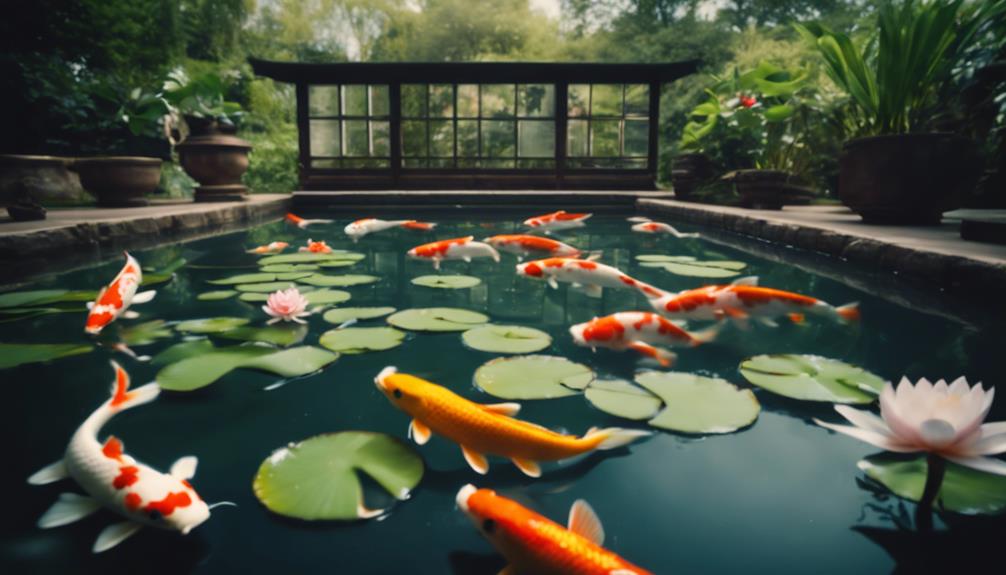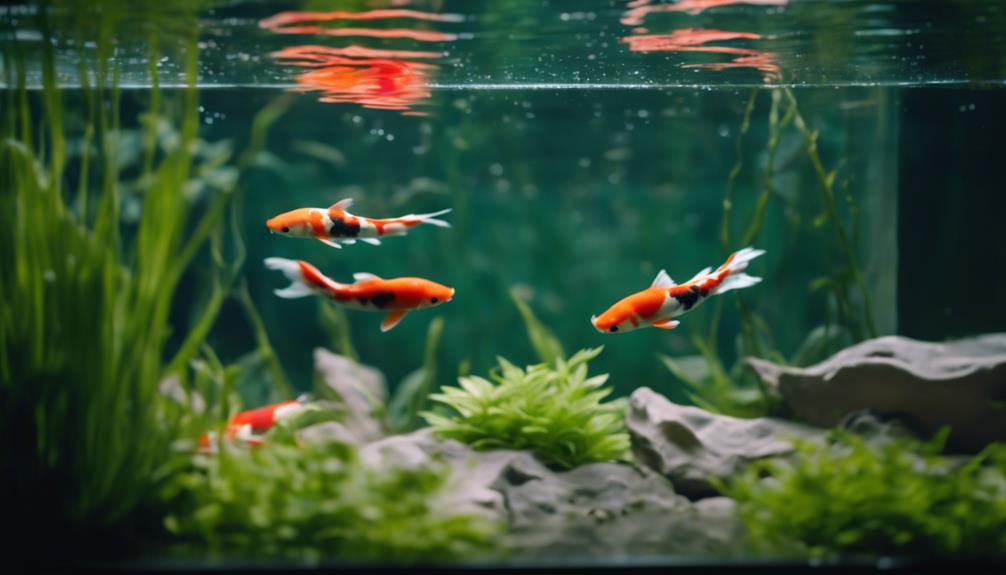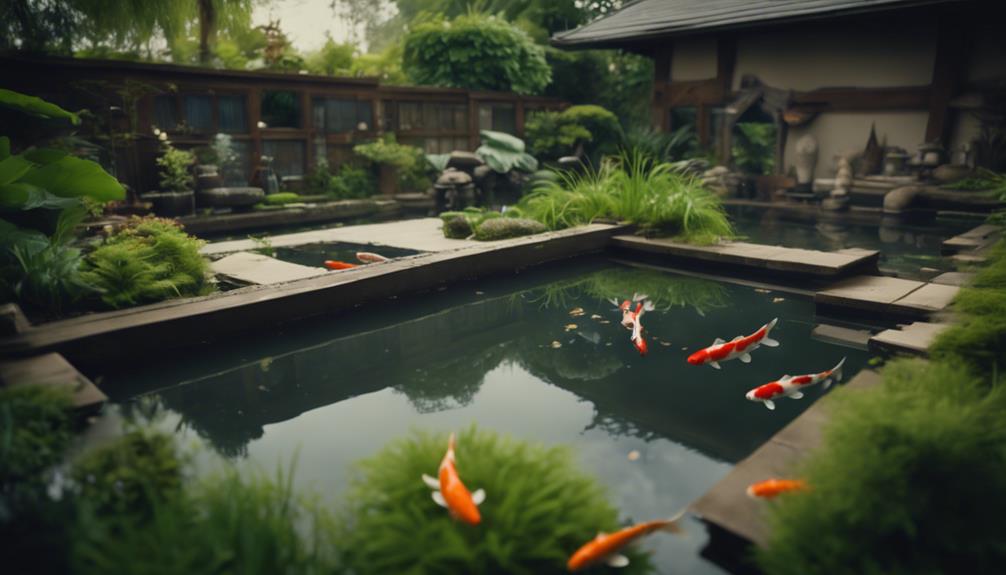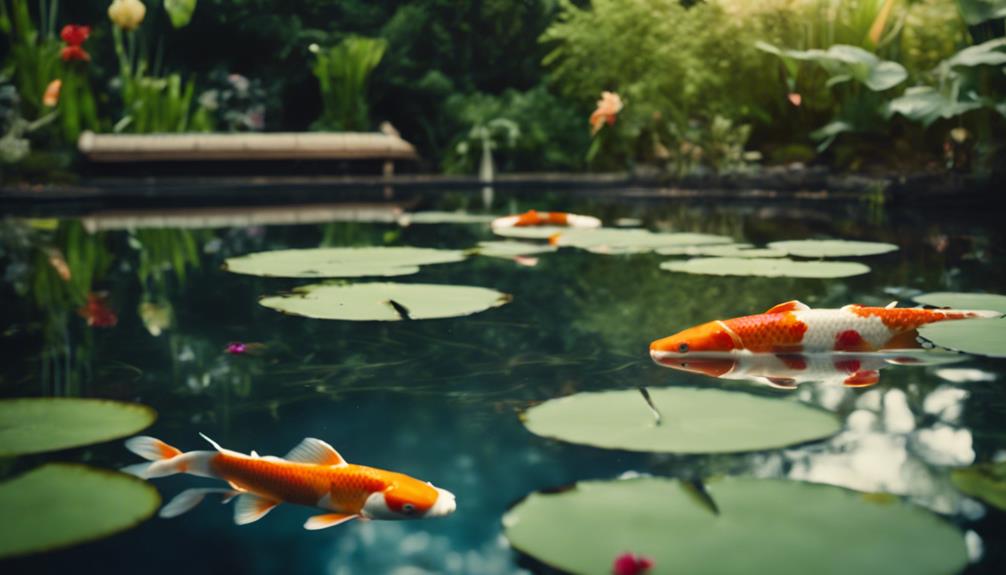You're about to breed koi fish for profit, a venture that demands meticulous attention to detail. Start by creating an ideal environment with water temperatures between 65ºF and 75ºF, ample space, and clean, well-oxygenated water. Select quality breeding stock with desirable traits, guaranteeing they're at least 3 years old and healthy. Next, set up a dedicated breeding tank with a precise temperature control system. Remove adult koi after spawning, and guarantee the tank has a filter system and a fry mat for eggs to hatch. Monitor water quality, feed young koi live foods, and shift to powdered pellets as they grow. Then, you'll be well on your way to building a successful and profitable koi breeding business, where a deep understanding of the market and a well-planned strategy can lead to a lucrative payoff.
Table of Contents
Key Takeaways
- Provide a well-maintained environment with clean, well-oxygenated water, and a balanced diet to promote healthy growth and fertility in koi.
- Select high-quality breeding stock with desirable traits, such as vibrant coloration and robust health, to produce profitable offspring.
- Maintain precise water temperatures and conditions during incubation and rearing to ensure successful breeding and healthy fry.
- Develop a plan with budgeting, marketing, and sales strategies to create a profitable koi breeding business and meet market demands.
- Research local market demand, trends, and prices to determine which varieties to breed and sell for maximum profitability.
Preparing the Ideal Environment
To successfully breed koi fish, you must first create an environment that closely replicates their natural habitat and provides ideal conditions for spawning and growth.
This requires careful attention to water temperature, which should range between 65°F and 75°F for peak breeding. Your koi farm or specialized koi pond should also provide ample space for male and female koi to swim freely, with a minimum depth of 3-4 feet and a surface area of at least 4 square meters.
During the breeding season, which typically occurs in late spring to early summer, you'll need to guarantee the water is clean and well-oxygenated.
Regular water changes and a balanced diet will help promote healthy growth and fertility in your koi.
A well-maintained environment will also reduce stress, which is vital for successful koi breeding.
By providing the right conditions, you'll increase the chances of successful spawning and growth, setting your koi up for a healthy and thriving life.
Selecting Quality Breeding Stock
When selecting quality breeding stock, you'll need to focus on specific criteria to guarantee the best possible outcomes.
You'll want to identify parent koi that exhibit desirable traits, such as vibrant coloration, symmetrical body shape, and robust health.
Koi Selection Criteria
You'll want to carefully evaluate your koi selection, as choosing the right breeding stock is crucial to producing healthy, high-quality offspring with desirable traits.
When selecting parent koi, choose those that are at least 3 years old, ensuring they're sexually mature and capable of producing healthy offspring.
You'll need a minimum of one male and one female koi with desirable characteristics such as healthy scales, desired fin shape, and color patterns.
Avoid breeding koi with injuries, as they may sustain further damage during breeding and pass on undesirable traits to their offspring.
Look for koi with healthy-looking scales, as they'll pass on this trait to their offspring, increasing the chances of successful breeding.
Select koi with desired fin shape, color, and other characteristics that are likely to be replicated in their offspring.
Healthy Parent Characteristics
As you set out on breeding koi fish for profit, selecting healthy parent koi is pivotal for producing high-quality offspring. Healthy parent koi exhibit robust physiques, free from visible injuries or diseases, ensuring they can withstand the rigors of breeding and pass on their desirable traits to their offspring.
When evaluating koi parents, look for the following characteristics:
- Vibrant coloration: Adult koi should display rich, vibrant colors, which are a hallmark of healthy, well-bred fish.
- Active swimming: Koi should swim actively and effortlessly, indicating good health and vitality.
- Proper body shape: A well-proportioned body shape, with a symmetrical and balanced appearance, is essential for breeding fish.
Creating Optimal Breeding Conditions

As you prepare to breed your koi fish, you'll need to create an ideal environment that fosters healthy spawning and development.
To do this, you'll need to control water temperature, set up a suitable breeding environment, and establish perfect spawning conditions.
Water Temperature Control
By maintaining a precise water temperature, breeders can create a perfect environment for koi to thrive, with the ideal range of 60-70°F during incubation being indispensable for successful breeding.
You'll want to aim for a temperature range of 65-68°F for ideal spawning, as this stimulates the female koi to release her eggs and the male koi to fertilize them.
Temperature fluctuations are a no-go: Any sudden changes in water temperature during incubation can lead to poor egg development, reduced hatching rates, and increased mortality in baby koi.
Invest in a reliable thermometer and heating system: These tools are pivotal for maintaining a consistent water temperature, especially during the sensitive incubation period.
Monitor air temperature too: A sudden drop in air temperature can trigger koi to spawn, so monitoring temperature changes closely is imperative during the breeding season.
Breeding Environment Setup
You'll need to set up a dedicated breeding tank with a minimum capacity of 200 gallons, complete with a reliable heating, filtering, and pump system to create ideal breeding conditions for your koi fish.
This will guarantee a clean pond with superior water quality, which is essential for successful breeding.
To safeguard your koi from predators and maintain clean water, consider using a specialized koi pond biofiltration system.
Don't forget to place a fry mat in the pond, providing a spot to lay eggs and increasing the chances of successful breeding.
Cover the pond with netting to protect your koi from cats, birds, and other predators.
Use a skimmer net or comparable scoop equipment to remove debris and trash from the pond's surface.
By maintaining a clean pond and minimizing disturbances, you'll create a perfect breeding environment for your koi fish.
With the right setup, you'll be well on your way to breeding healthy, thriving koi fish for profit.
Optimal Spawning Conditions
To create ideal breeding conditions, breed your koi in late spring and early summer when they're naturally inclined to spawn, and maintain a water temperature of 60-70°F during incubation to promote healthy egg development and hatching. This perfect timing and temperature range will increase your chances of successful spawning.
Provide a suitable spawning surface: Offer a fry mat or a similar device for your koi to lay eggs confidently. This will encourage spawning and reduce egg loss.
Maintain water quality: Keep the water clean and well-maintained by using a skimmer to remove froth or scum. You can also add whole lettuces to the pond to help absorb excess nutrients.
Minimize disturbance: Cover the pond to reduce external disturbance and guarantee minimal changes in water temperature or quality during incubation.
Caring for Fertilized Eggs
Once fertilized eggs are identified, immediate attention turns to creating a safe and healthy environment for them to hatch and develop.
You'll need to remove the adult koi from the breeding tank to prevent them from eating the eggs.
Certify your koi tank has a filter system and is clean to support the health of your young koi.
Monitor water quality and make adjustments as necessary to support the growth of your koi fry. Ideal water parameters include a temperature range of 60-70°F and zero ammonia levels.
A water change is advised since mating can produce a stench and make the water cloudy. Pay close attention to ammonia levels to prevent harm to your young koi.
Finally, guarantee your koi tank has a fry mat or similar device for the eggs to hatch and for the young koi to hide and feel secure.
Nurturing Young Koi Fish

Carefully nurturing your young koi fish during their early stages is crucial, as they're vulnerable to predators and water quality issues. After the yolk has been absorbed, usually within 24 hours, you'll need to provide them with nutritious food.
Feed them live foods: Commercial Brine shrimp are an excellent option, providing essential proteins and nutrients.
Use commercial baby koi meal kits: These are convenient and nutritionally balanced, and can be fed 4 times a day.
Transition to powdered koi pellets: After 10 days, feed your baby koi powdered koi pellets 4 times a day, and continue until they're 4 weeks old, gradually increasing food size as they grow.
Managing Breeding Risks and Challenges
As you venture into koi breeding, you'll inevitably face a multitude of challenges that can impact the health and well-being of your fish, your finances, and even your emotional state.
One of the most significant risks is the breeding process itself, which can be stressful and even injurious to female koi. Removing the males after spawning can help mitigate this risk, but it's vital to monitor ammonia levels closely to prevent toxicity.
Single pregnancies can result in a large number of offspring, requiring culling to maintain a healthy and sustainable population – a difficult and emotional task for many breeders.
Additionally, diseases and parasites can spread quickly through your koi population, making quarantine and treatment protocols essential.
Managing breeding risks requires careful planning, attention to detail, and a deep understanding of the breeding process. By being aware of these challenges, you can take steps to minimize their impact and guarantee the success of your breeding operation.
Building a Successful Breeding Business

You'll need to shift your focus from managing breeding risks to building a successful koi breeding business, which requires a clear understanding of your target market and a well-planned strategy for meeting its demands.
To do this, you'll need to research and understand local market demand, trends, and prices to determine which varieties to breed and sell.
Breeding koi with specific colors or patterns can command higher prices and increase profitability.
Providing excellent customer service and building a reputation for quality koi can attract repeat customers and help establish a loyal client base.
Developing a plan that includes budgeting, marketing, and sales strategies is vital for creating a successful and profitable koi breeding business, and it's essential to ponder this aspect when establishing your venture.
Frequently Asked Questions
How to Breed Koi Fish for Profit?
To breed koi fish for profit, you'll need to master koi selection, guarantee fish compatibility, and control breeding triggers, while maintaining ideal water parameters, inducing spawn, managing broodstock, testing fertility, and preserving genetic diversity.
What Should You Do First Before Attempting to Breed Koi?
Before diving into the world of koi breeding, you'll want to establish a solid foundation – start by researching the koi selection process, ensuring you have the necessary breeding experience, and crafting a fish nutrition plan to support healthy offspring.
How Do You Prepare Koi for Breeding?
You'll prepare koi for breeding by selecting mature fish with desired traits, improving water quality with a proper filtration system, and optimizing tank conditions, nutrition, and breeding triggers to stimulate spawning in designated areas.
Is It Hard to Get Koi to Breed?
'Can you really blame koi for being finicky about breeding? You'll need to guarantee they're mature, trigger breeding with perfect water quality and tank size, and select compatible fish with the right genetic factors.'
Conclusion
By following these 7 essential tips, you'll be well on your way to cultivating a thriving koi fish breeding business.
Craft a careful climate, choose champion breeding stock, and cultivate conditions conducive to conception.
Carefully care for eggs, nurture newborns, and navigate potential pitfalls.
Finally, build a business that's both profitable and prestigious, propelled by your passion for precision and dedication to detail.

